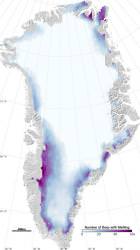The island of Greenland experienced more days of melting during 2006 on average than in the last 18 years, according to new NASA-funded research.
The data were gathered by the Special Sensor Microwave Imaging radiometer (SSM/I) flying aboard the Defense Meteorological Satellite Program spacecraft. It can peer through the clouds, and measure the rates of melting every day. During 2006, researchers estimated that portions of Greenland melted for an additional 10 days beyond averages.
Melting water on Greenland will impact global water levels. But the water can also slip down through cracks in glaciers, and lubricate the ice sheet. This can speed up the movement of glaciers, which eject ice into the ocean, and further accelerate sea level rise.
Original Source: NASA News Release

